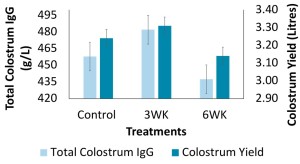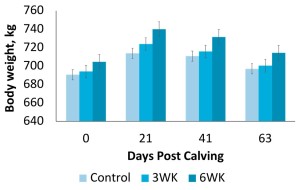By Madi Lewis, Katie Wood, Koryn Hare, & Michael Steele
Introduction
Late gestating beef cattle experience increased nutrient demands during the final two month prior to calving due to exponential fetal growth (Bauman and Currie, 1980). In these final two months, the fetus will gain approximately 60% of its birthweight, and mammary gland development is occurring as the dam prepares for production of colostrum and lactation (Bauman and Currie, 1980). The process of colostrum production relative to calving is not well understood. Previous work has shown that cows supplemented with excess energy prior to calving experience minimal calf size effects, an increase in colostrum quality and output, and minimized condition loss (Bauman and Currie, 1980). Based on previous studies, late gestation metabolizable energy over-supplementation could cause different responses depending on the duration of supplementation relative to time of calving.
Objective
Given the expense of supplementation with commodities such as corn, it is important to investigate the effect of duration of supplementation on cow and calf performance, as well as colostrum yield and quality (Baumrucker & Bruckmaier, 2014).
The objective of this study was to investigate how supplementing more metabolizable energy than the cows’ requirement for 3 compared to 6 weeks would impact colostrum quality and quantity and cow and calf performance. It was hypothesized that over supplementation of metabolizable energy 3-weeks prior to parturition would be as beneficial to colostrum production as supplementing for 6 weeks.
Methods
This study took place at the Ontario Beef Research Centre (OBRC, Elora, ON, Canada) with a total of eighty-two gestating Angus-Simmental beef cows. Cows were assigned groups by predicted calving date based on an estimated gestation length of 282 days and body weight. Prepartum, the cows were housed by treatment in pens of 6 animals; each pen shared three Insentec Feeding Systems, which allowed for individual feeding behavior and intake to be recorded.
Cows were assigned to one of three treatment diets: (1) 100% metabolizable energy requirement (Table 1, CTRL, 24 cows), (2) 120% of their predicted metabolizable energy requirements for 3 weeks prior to calving (Table 1, 3WK, 30 cows), or (3) 120% of their predicted metabolizable energy requirements for 6 weeks prior to calving (Table 1, 6WK, 28 cows).
The cows weighed an average of 715 kg with a body condition score of 3.5, with an average parity of 3.2 years at 270 days of gestation. Changes in metabolizable energy between treatment diets was achieved through the inclusion of whole corn for the 3WK and 6Wk treatments. Cows were placed on a two-week adaptation period prior to the start of the treatments, during this time they were fed the control diet. After calving, all cows were fed a common lactation ratio and were fed free choice.
Cows on the 3WK treatment were fed the treatment diet starting at roughly13 days prior to calving. Cows on the 6WK treatment were fed treatment diet starting at roughly 33 days prior to calving.
To keep track of performance during gestation, cow weights, ultrasound for rib and rump fat, and blood samples were collected from cows. At time of calving, cows had a full-udder of colostrum which was collected with a portable milking machine. Postpartum, weights, ultrasound and blood samples were collected from the cows to track their performance. Calf birth weights were also recorded at birth and calves were weighed weekly thereafter. A blood sample was obtained at about 48 h of age to assess passive transfer of IgG antibodies.
| Table 1. Prepartum diet ingredient inclusion, chemical composition and feeding rate designed to supply pregnant cows with 100% (control) or 120% of their predicted ME requirements for 3 weeks (3WK) or 6 weeks (6WK) relative to calving. | ||
| Item | Control | Treatment |
| Feeding rate, DM %BW | 1.4 | 1.45 |
| Diet composition, %DM | ||
| Haylage | 5 | 5 |
| Corn Silage | 5 | 5 |
| Chopped Dry Hay | 37.5 | 44.5 |
| Wheat Straw | 30 | 5 |
| High Moisture Corn | 18.5 | 18.5 |
| Whole Corn | 0 | 18.5 |
| Urea | 0.5 | 0 |
| Vitamin and Mineral Premix | 3.5 | 3.5 |
| Forage, %DM | 77.5 | 59.5 |
| Concentrate, %DM | 22.5 | 40.5 |
| DM, % | 80.86 | 80.76 |
| Chemical composition, %DM | ||
| CP | 10.62 | 10.83 |
| Soluble protein | 4.19 | 2.77 |
| aNDFom | 51.91 | 36.78 |
| Sugar | 3.09 | 3.32 |
| Starch | 14.95 | 26.98 |
| EE | 2.57 | 3.02 |
| Ca | 0.66 | 0.66 |
| P | 0.34 | 0.41 |
| Mg | 0.25 | 0.26 |
| K | 1.57 | 1.64 |
| DM = dry matter, CP = crude protein, aNDFom = amylase Neutral Detergent Fiber organic matter, EE = ether extract | ||
Results
Cows calved earlier than anticipated, resulting in an average of 14 d and 33 d before calving, The results of this study did not find any differences in colostrum yield (P = 0.9) or composition (fat, crude protein, lactose, glucose, or gross energy; P > 0.3) because of supplementation, nor were there differences due to duration of supplementation of energy relative to control diets at 100% of ME requirements (Figure 1). Total IgG concentration in colostrum was also not impacted by dietary treatment (P = 0.8).
Supplementation also did not impact cow performance measurements before calving, as supplemented cows had similar rib and rump fat depth, and similar body weight (P > 0.4). Greater levels of metabolic markers of fat mobilization were seen in the control cows, suggesting that these cows may have had to use more body reserves to meet their energy demands, although the insufficiencies did not impact overall performance. Similarly, up to 63 d postpartum, there were no dietary treatment differences in cow bodyweight or rib and rump fat measurements (P > 0.5). However, cows supplemented for 3 and 6 wks prepartum had positive bodyweight gain over the entire study (-53 to 63 d ; 9.4 and 18.5 kg respectively; P < 0.001), while control cows lost approximately 11 kg body weight, despite being fed the same diet postpartum.
There were no treatment differences for calf birth weights (P = 0.3). Interestingly, calves from cows that were supplemented for 6 weeks did have greater average daily gain for the first 7 days of life compared to cows that were supplemented for 3 weeks (1.64 vs 1.24 kg/d, respectively; P =0.02), while control remained intermediate. After the first 7 days of life, calf weights and average daily gain were not affected by maternal supplementation (P = 0.3)
Conclusion
The results of this study did not support the initial hypothesis that over-supplementation of metabolizable energy for durations of 3WK or 6WK prior to calving would affect colostrum production and calf performance differently, due to being applied at differ stages of colostrum production relative to cow supplemented at 100% of requirements. However, supplementation did improve body weight gain in cows, which may be beneficial to producers prior to breeding.
As cows in this study calved earlier than expected, the much shorter duration of supplementation of 33 and 13 days could have limited differences seen relative to the hypothesis; prolonging the duration of supplementation closer to our target duration may change results. This would aid the beef industry to discover the most ideal time period for metabolizable energy supplementation to improve both cow and calf performance, while optimizing colostrum yield and composition.
I would like to thank the Elora Beef Research Centre Staff, Amber Zupan, and Tatum Schooley, and Dr. Katherine Wood’s lab for their technical support on this project. Funding for this study was provided by the BCRC, OMAFRA and NSERC
References
Bauman D, Currie W (1980). Partitioning of nutrients during pregnancy and lactation: a review of mechanisms involving homeostasis and homeorhesis. Journal of dairy science, 63(9), 1514-1529.
Baumrucker, C.R., & Bruckmaier, R.M. (2014). Colostrogenesis: IgG1 transcytosis mechanisms. Journal of Mammary Gland Biology and Neoplasia, 19(1), 103-117.



